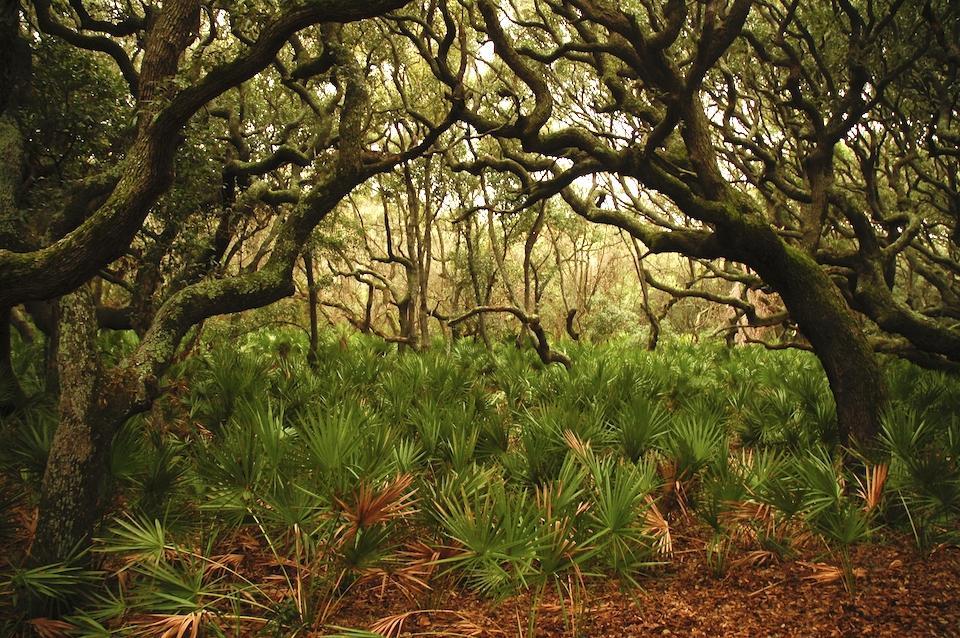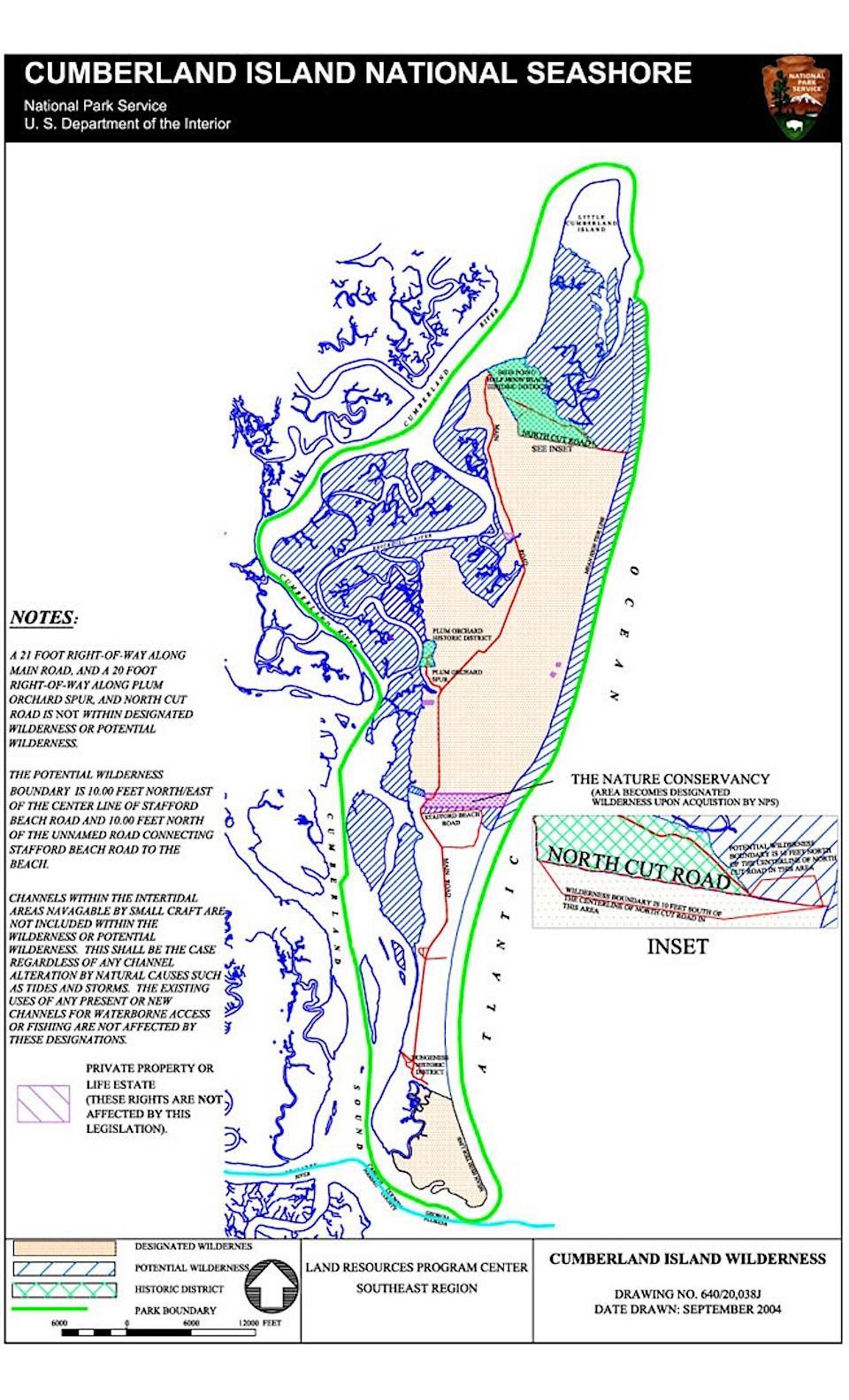
The prospect of rockets roaring over Cumberland Island National Seashore's maritime forests moved closer to reality Monday/NPS file
Editor's note: This updates with comments from the Cumberland Island superintendent, deletes outdated material.
Rockets soaring across Cumberland Island National Seashore along the Georgia coastline moved a step closer to reality Monday when the Federal Aviation Administration granted a license to Spaceport Camden, though that in itself does not authorize actual launches.
Camden County officials still must finalize the purchase of a roughly 4,000-acre site owned by Union Carbide, a step thousands of county residents hope a judge will block by issuing a temporary restraining order until a referendum can be held on the spaceport.
In issuing the operating license, the FAA cautioned that more regulations stand in the way of any actual launches from the proposed spaceport, which would be located roughly 3.5 miles west of the national seashore.
"Protecting public safety is the Federal Aviation Administration’s top priority when evaluating applications for commercial space licenses. After completing an environmental and safety review, the FAA is issuing a license for Spaceport Camden in Georgia. This license does not authorize a single launch," read a statement the FAA released Monday. "For launches to occur, a commercial space transportation company must obtain its own license that requires additional and stringent regulatory safety and environmental reviews. Simply put: Before any potential launch can occur, many more reviews remain and no outcome is guaranteed."
At Cumberland Island National Seashore, Superintendent Gary Ingram said, "[W]e have collaborated with the FAA, providing critical input aimed at protecting the visitors, staff, and nationally significant resources entrusted to our care. We remain committed to working with the FAA to adequately address remaining concerns about adverse impacts to the park.”
Under terms of the five-year license, as many as a dozen commercial launches a year could arc across the northern end of Cumberland Island National Seashore, where the seashore's official wilderness area spans more than 9,800 acres, with another adjacent 10,000-acre tract of potential wilderness. The trajectory cone also encompasses much of Little Cumberland Island, which is private property but within the seashore's boundaries.

The northern half of Cumberland Island National Seashore is a mix of designated and potential wilderness/NPS graphic
Camden County residents who have asked Superior Court Judge Stephen G. Scarlet to block the county's purchase of the Union Carbide site until a referendum can be held on the spaceport are determined to continue their fight to halt it. The Southern Environmental Law Center also has been watching the matter and criticized the FAA's decision.
“Virtually from the start, the FAA’s review of Spaceport Camden has been fraught with factual mistakes and legal errors," Brian Gist, a senior attorney with SELC, said in a statement without elaborating. "We will carefully review the FAA’s decision to ensure that it fully complies with all applicable laws.”
However, SELC in the past has raised questions about whether the FAA adequately addressed the risk of rocket failures, how wildfires started by failed launches would be controlled, and the extent of public access restrictions on the national seashore.

Cumberland Island is one of the most important nesting areas for endangered loggerhead sea turtles in Georgia/NPS file
At the National Parks Conservation Association, Southeast Regional Director Emily Jones was outraged by the FAA's decision.
“Blasting rocket ships over national parks threatens visitor safety, wildlife and the very values for which Cumberland Island National Seashore was protected," she said in a statement. "Our national parks were set aside for the enjoyment of all – not a select few. Building Camden Spaceport is unacceptable and opens the door to further destruction. The potential damage to sights, sounds and overall experience at the remote barrier island national park would forever scar the landscape and waterways surrounding it.
“For years, the National Parks Conservation Association has stood firm against Camden Spaceport, which would be a blight on an iconic national park site in Georgia and the precious resources it protects, including one of the most important loggerhead sea turtle nesting areas in the country," she continued. "In addition to the harmful impacts to the park itself, this project poses a serious threat to the local economy created by national park visitors and hardworking vendors, outfitters, and many local businesses.”
Wayne R. Monteith, FAA's associate administer for commercial space transportation, told Matthew Strickler, Interior's deputy assistant secretary for fish, wildlife and parks, in a letter dated December 16 that the license authorization "would not authorize a single launch," and that "it does not predetermine the outcome of an additional independent review of any future application for a Vehicle Operator License necessary for launches."
A request for the operator license would trigger another round of environmental studies, added Monteith.
"This includes a flight safety analysis that details the specific vehicle trajetory, and associated safety zones..." he wrote. "Any subsequent evaluaton could rearch different conclusions about impacts on the environment, climate change, safety, historic properties, or federally protected lands than the Spaceport Camden EIS due to new and more specific information regarding the proposed launch vehicle trajectory, vehicle design and operating specifications, or other factors."
The letter was obtained by Taxpayers Against Camden Spaceport.

The proposed flight trajectory would take rockets over Cumberland Island's official and proposed wilderness areas/FAA final EIS
While NASA long has handled space launches for the United States, recent years have seen the rise of private rocket companies that see a profit to be made in taking on at least some of NASA's workload, and commercial spaceports have surfaced to support those companies.
Camden County is just one of the latest communities to explore the possibilities of a spaceport. Other entities in Florida, Texas, New Mexico have looked into spaceports, and Virginia is an official partner with NASA at the Mid-Atlantic Regional Spaceport on Wallops Island.
According to The Pew Charitable Trusts, “the commercial space industry is worth $345 billion globally,” and while there might not currently be a need for commercial spaceports around the country, those behind proposals such as Camden County’s are betting on the future.
Cumberland Island was added to the National Park System in 1972. Accessible only by boat, the national seashore features unspoiled beaches and dunes, marshes, and freshwater lakes, along with historic sites. Twisting live oaks covered in resurrection ferns and spanish moss make up the island's maritime forest, shading an understory of sable palms and palmettos. Facing the mainland, the island gazes across mudflats during low tide and swaying marshes. Looking to the east, visitors step through designated pathways between rolling dunes to hit the sandy beach bordering the Atlantic Ocean. During low tide, sand appears to stretch in all directions.
It's this largely unspoiled setting that is at risk from the proposed spaceport.
Interior Department staff, on behalf of the NPS, raised a number of concerns when it commented on the draft EIS in June 2018. Among those concerns:
• “Sky glow” from launches would be widely visible on the northern end of the national seashore and “not likely be limited to west shoreline areas only”;
• Launches would lead to adverse soundscape impacts to the cultural landscape of the seashore: “The character and intensity of the noise resulting from launches is in contradiction to the current setting”;
• “There is no mention of the potential for flaming debris to fall on land. What is the likelihood for this type of catastrophic event and the associated impacts?”
• The DEIS lacked sufficient analysis of how launches might affect wildlife;
• The DEIS failed to mention “what type and volume of materials can be expected to discharge from rockets?”;
• The DEIS failed to accurately project the “frequency of delays, scrubs, and reschedules” of launches that could in turn impact the seashore and its visitors.
Other concerns touch on whether visitors to Cumberland Island would have to leave the park during launch windows; would the Park Service be responsible for emergency response in the event of a launch failure; would the Park Service be responsible for seeing visitors safely escorted off the island; would visitors who reserved backcountry trips months in advance have to cancel them if a launch date coincided with their trips; is it possible to mitigate a launch’s audible impacts on official wilderness; how would launches impact rookeries on the island?
The FAA's final environmental impact statement on the spaceport acknowledged the risk of aborted launches, stating that "[A] launch failure may produce a short-term, highly visible cloud of fire, smoke, and steam at the launch site or in the air, depending on where the failure occurs in the launch sequence. Following the extinguishing of the associated fire and recovery of any associated debris, no long-term offsite visual changes would result."
At the same time, the EIS also said the "[A]dverse impacts on recreational use within the operational ROI would be short-term and temporary during launch operations and would not result in long-term preclusion of certain uses, prohibition or severe access limitations to certain areas, and/or severe alterations or diminished aesthetic recreation experiences (e.g., wilderness solitude).
"Long-term impacts to the solitude quality of the Cumberland Island Wilderness would result from the sky glow and visual intrusion of the spaceport towers/facilities, but only from west shoreline areas," the EIS continued. "No substantial long-term annoyance (i.e., noise-compatible land use impacts) and/or permanent conflicts with landowers has been identified."
But the EIS also acknowledged that the wilderness experience on the national seashore could be impacted from the noise of launches.

 Support Essential Coverage of Essential Places
Support Essential Coverage of Essential Places



